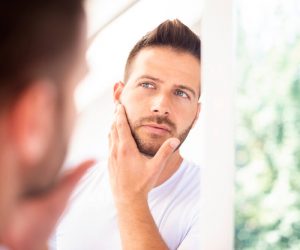How to Treat a Red Face from Alcohol

Why Does Alcohol Make Your Face Turn Red?
The “alcohol flush reaction” is a common experience for many people after a few drinks and usually occurs due to the body’s difficulty digesting the alcohol. Aldehyde dehydrogenase 2 (ALDH2) is an enzyme that helps to break down the acetaldehyde in alcoholic drinks. If you have a faulty version of the gene that controls this enzyme, an excess of acetaldehyde will build up in your system, causing a red face and other symptoms such as alcohol intolerance.
It is estimated that at least 540 million people, or 8% of the population of the world, have this issue, especially those of East Asian descent, with between 36 and 70% of those with Korean, Japanese, and Chinese genetics affected (this is sometimes called “Asian flushing”). People with Jewish ancestry are also primarily represented in these statistics. Along with the red face that comes with drinking, people with this specific genetic issue who consume alcohol may also experience:
- Headaches
- Nausea and vomiting
- Rapid heartbeat
Is Having a Red Face from Drinking Dangerous?
The alcohol flush reaction (red face after drinking) that many people experience is not dangerous, but it could be a serious warning sign of other health issues. People who become flushed while drinking has a higher chance of developing high blood pressure, which may, in turn, increase the chances of stroke and heart disease in the future.
Those who experience facial flushing after drinking may also be associated with a higher risk of developing cancer, especially in the esophagus in East Asian men. However, this association was not found in women from the same area. Facial flushing, therefore, may be one way to help identify people who are at risk of developing these diseases in the future.
Tips for Treating Redness Caused by Drinking
If you are wondering how to treat a flush response to red face from alcohol, you should talk to your doctor. They may suggest trying medications called histamine-2 (H2) blockers to help control the development of a red face while drinking. They can slow the breakdown of alcohol into the troublesome acetaldehyde in the bloodstream. Common brands of these H2 blockers include:
- Tagamet
- Zantac
- Pepcid
Your doctor may also choose to use Brimonidine or Oxymetazoline. These temporary topical ointments reduce the size of blood vessels in the face and are often prescribed for the treatment of rosacea. Laser therapy and light-based therapies can also help reduce the appearance of redness on the face.
All these treatments are temporary fixes to an underlying issue, and they do not address the Aldehyde dehydrogenase 2 deficiency and can mask essential symptoms of alcohol intolerance. If you are looking for a more permanent solution, a luxury rehab in Florida can help you to address the root cause of your alcohol intolerance and develop healthy coping mechanisms.
How to Prevent Facial Flushing From Alcohol
Limiting alcohol consumption is good for anybody, even without facial flushing. Alcohol-related deaths make up 5% of all deaths worldwide, and regular alcohol consumption increases the risk of developing diseases and medical problems like:
- Liver disease
- Cancer
- Heart disease
- Stroke
- High blood pressure
- Memory and cognitive issues
- Insomnia
- Serious digestive problems
- Weight gain
Moderate drinking may work for many folks, with one drink per day (seven per week) for women and two drinks per day (14 per week) for men as the maximum amount, but for others, abstinence may be the best choice, especially if facial flushing is an issue.
Regular consumption of alcohol, including heavy or binge drinking, can affect your health, work and finances, relationships with others, and mental health. Being honest with yourself about how your drinking affects your life is the best way to keep yourself in check and know when it may be time to get help to quit drinking.
See how quitting alcohol can improve your appearance here:
https://whitesandstreatment.com/2019/02/19/how-quitting-alcohol-changes-your-appearance/amp/
Need More Support? Alcohol Treatment at WhiteSands
If you believe you may have an alcohol use disorder, feel the need to drink to avoid withdrawal symptoms, or just get through the day, it may be time to seek professional help to quit. It is never recommended to stop heavy drinking on your own, as it can be dangerous to your health or even deadly, especially if you try to quit “cold turkey.”
WhiteSands Alcohol and Drug Rehab In Tampa can help you detox safely from alcohol, without suffering, with 24-hour medical supervision and care, followed by a comprehensive rehabilitation plan with inpatient rehab, partial hospitalization, and intensive outpatient program options. We will help you work through underlying issues such as trauma and mental illness in dual diagnosis treatments. We also provide therapy for social problems and medical care for physical health issues as you gain coping skills, life skills, and recovery techniques that will last you a lifetime, all within our luxury rehab programs.
If you believe you may be an alcoholic or want more information on alcohol use disorder, safe medical detox, and the trauma-informed luxury rehab programs in Florida we offer, contact us today to find out more about how we can help you.
If you or a loved one needs help with abuse and/or treatment, please call the WhiteSands Treatment at (877) 855-3470. Our addiction specialists can assess your recovery needs and help you get the addiction treatment that provides the best chance for your long-term recovery.

